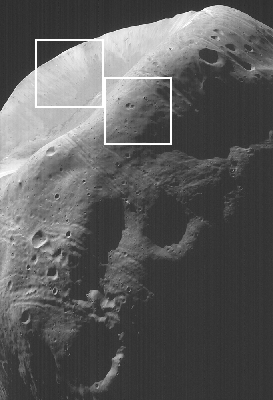

Mars Global Surveyor Mars Orbiter Camera Release: MOC2-66a, -66b, -66c, -66d, -66e Mars Global Surveyor Mars Orbiter Camera Image ID: 588013457.50103 P501-03

|
Click Here for more information on MGS data release and archiving plans. |
CAPTION
Phobos, the inner and larger of the two moons of Mars, was the subject of several close observations taken by the Mars Global Surveyor during the past month. The observations shown here were acquired during the second encounter, on August 19, 1998. The minimum distance between the spacecraft and Phobos was 1080 km (671 mi). Both the Mars Orbiter Camera (MOC) and Thermal Emission Spectrometer (TES) observed the natural satellite of Mars.MOC image 50103 (A) is one of the highest resolution images (4 m = 13 ft per picture element) ever obtained of the Martian satellites. The image shows several new features of this lumpy moon--features that are associated with the prominent crater seen in the upper left quarter of the image. This is the largest crater on Phobos, Stickney, 10 km (6 miles) in diameter. Individual boulders are visible on the near rim of the crater (D), and are presumed to be ejecta blocks from the impact that formed Stickney. Some of these boulders are enormous--over 50 m (160 feet) across. Also crossing at and near the rim of Stickney are shallow, elongate depressions called grooves that may be expressions of fractures caused by the formation of this crater that is nearly half the size of the satellite. The far wall of the crater shows lighter and darker streaks going down the slopes (C). The presence of material of different brightness on the far crater slopes, and in some of the grooves, shows that the satellite is heterogeneous (that is, it is made of a mixture of different types of materials). The motion of debris down slopes is guided by gravity, which is only about 1/1000th that of the Earth--e.g., a 150 pound (68 kilograms) person would weigh about 2 ounces (57 grams) on Phobos!. Previous images from the Viking Spacecraft in the 1970's were not of sufficient resolution to show the effectiveness of gravity on Phobos in moving material down slopes.
The Thermal Emission Spectrometer (TES) measured the brightness of thermal radiation at the same time MOC acquired its image. By analyzing this brightness, TES scientists could deduce the various fractions of the surface exposed to the Sun--and their temperatures--as the first step in a time-consuming and sophisticated process by which they will ultimately determine the nature of the debris on the surface (for example, what sizes of materials are moving down slope) and its composition. This preliminary analysis shows that the surface temperature, dependent on slope and particle size, varies from a high of +25° F (-4 ° C) on the most illuminated slopes to -170° F (-112° C) in shadows. This large difference, and the fact that such differences can be found in close proximity, adds support to the notion that the surface of Phobos is covered by very small particles.
Malin Space Science Systems and the California Institute of Technology built the MOC using spare hardware from the Mars Observer mission. MSSS operates the camera from its facilities in San Diego, CA. The Thermal Emission Spectrometer is operated by Arizona State University and was built by Raytheon Santa Barbara Remote Sensing. The Jet Propulsion Laboratory's Mars Surveyor Operations Project operates the Mars Global Surveyor spacecraft with its industrial partner, Lockheed Martin Astronautics, from facilities in Pasadena, CA and Denver, CO.
